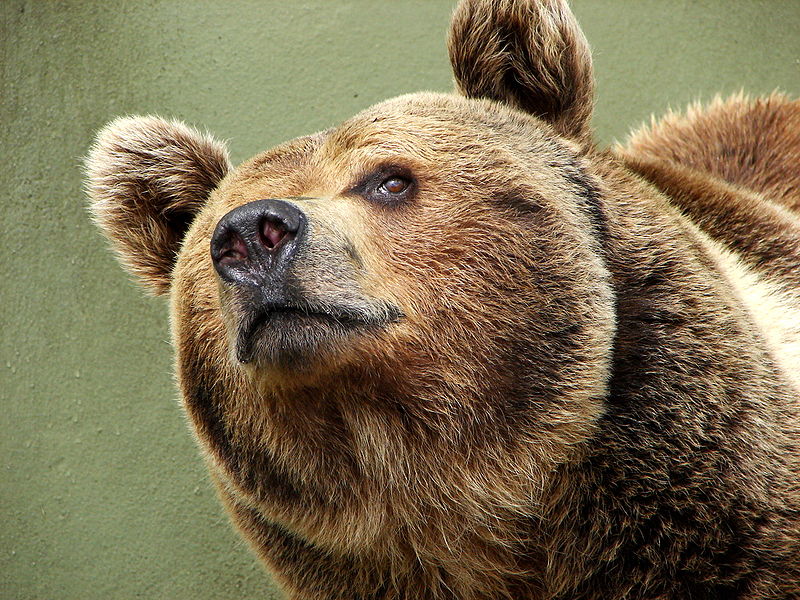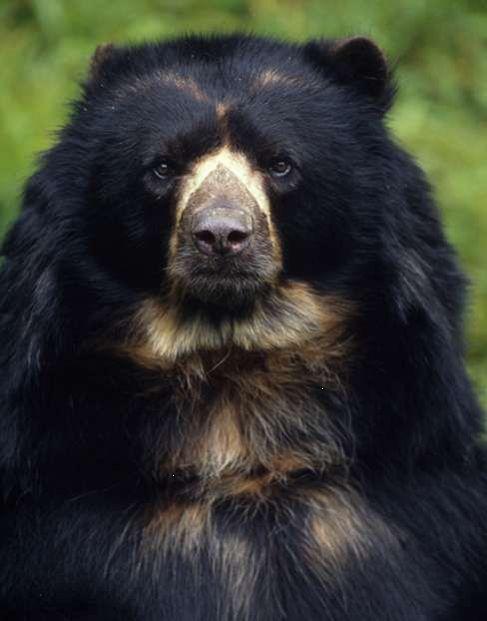A (partial) Guide to Recognizing Your Bears

Brown Bear:
Range: Northern North America, Europe, Asia, Wall Street.
Diet: Lots of vegetation, berries, fruit, carcasses, fish, grubs. Mammals great and small, if it feels like a chase. Grizz eats whatever the hell it wants.
American
Black Bear:
Range: Behind you!
Diet: Mostly vegetation, berries, roots, grubs, fruit, honey. Also, carrion, trash, dog food, baking supplies, anything they can get their paws clawed on.

Polar Bear:
Range: The Arctic.
Diet: Ringed, harbor, bearded, harp, and hooded seals, other blubbery marine mammals, including the occasional beluga whale. I said whale!
Random fact: The biggest in the family, polar bears are so well insulated their body heat does not register on an infrared devise. This makes them excellent spies.
Range: Mountain and tropical forests of Southern Asia, Northeast India, etc.
Diet: See American Black Bear.
Random Fact: These guys are largely nocturnal, and are called Moon Bears because of that crescent-shaped chest bling they sport. Dandies.
 |
| Get it together, Sun!. You look like a Shar Pei with heat stroke. |
Sun Bear:
Range: Rain forests in various Southeast Asian countries.
Diet: Typical jungle fare: honey, insects, veg, fruit, rodents.
Random Fact: Rarest. Smallest. Most ornery. Sun bears love slurping up honey and termites with their crazy long, skinny, semi-creepy tongue.
~ ~ ~Intermission~ ~ ~
 | ||
| Hello, is it me you're looking for? |
Range: Forest and grasslands of India,
Nepal, Bangladesh, etc.
Diet: Mostly termites and ants (check out
that schnoz), but anything will do.
Random Fact: The Sloth Bear's Lionel
Ritchie-esque shaggy faux-mullet ear/neck
fur help keep little insects away. And that
ain't the half of it. They have long tongues,
can close their nostrils and curl their lips
over their noses, and lose their front top
canines, all to better suck up insects.
Apparently their aggressive hoovering
can be heard 300 meters away.
 |
| Not amused |
Spectacled Bear:
Range: Northern and Western South
America.
Diet: Fallen fruits, palm nuts, orchid
roots, honey, sugarcane, cactus.
Random Fact: Closest living relatives
of the epic Short-Faced Bear of
Pleistocene fame. Named for face
markings vaguely reminiscent of
corrective eye wear.
 | ||||
| Ready for my close-up |
Panda Bear:
Range: Southeast China.
Diet: Bamboooooo! Only bamboo.
International poster bear for adorable.
 Care Bear:
Care Bear: Range: Kingdom of Caring, Care-A-Lot, the Forest of Feelings, my first-grade birthday cake. Diet: Sugared cloud cones, the hopes and dreams of young children, mainlined love.
Bear Grylls:
Range: Atop Mount Everest, north-Atlantic icebergs, jungle ditches, free falling through mid-air, under piles of leaves, up in trees, on book stands everywhere.
Diet: Raw organs, insects great and small, urine, deer shit, real vowels, and basically whatever it takes to SURVIVE!

Gummi Bear:
Range: Happy bellies and cavity-ridden mouths worldwide.
Diet: You're not on one if you're eating these bears.
The Gay Man's Bear:
Range: San Fransisco, Miami, D.C., New York, Seattle, worldwide. Diet: Listen, what a bear eats in the privacy of his own home is no body's business but his own.

Chicago Bear:
Range: Chicago and fields away.
Diet:





coors? PSHAW. Old Style
ReplyDeleteVery good blog and very good information. Please visit my blog:
ReplyDeleteHoney loving bears with long tongue